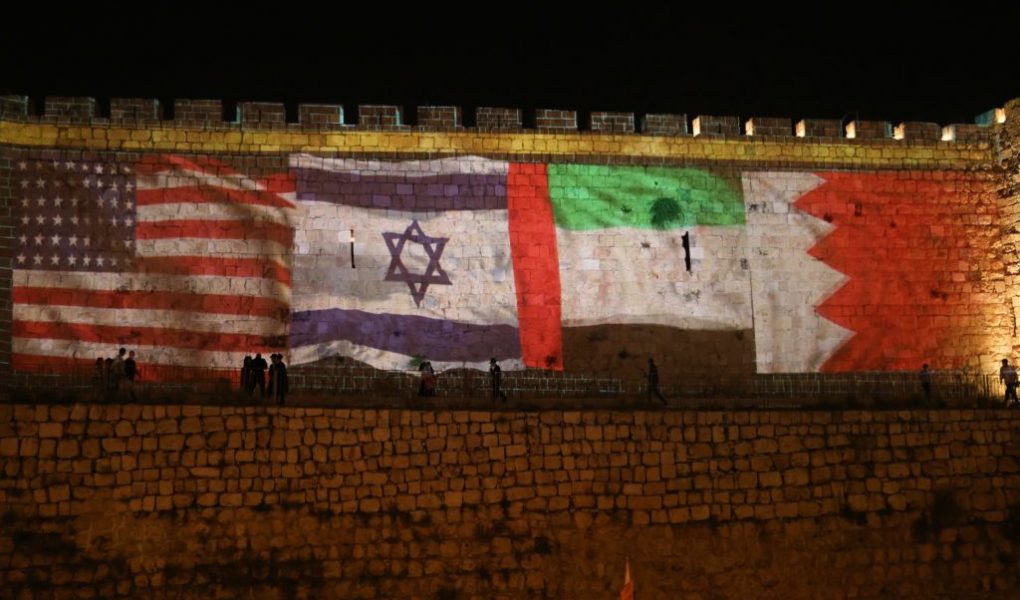When U.S. President Joe Biden made the short hop from Israel to Saudi Arabia aboard Air Force One in July, it aptly symbolized the Middle East’s growing regional connections. Nearly two years after the signing of the Abraham Accords—the historic peace agreement between Israel, the United Arab Emirates, and Bahrain—the next steps in Middle Eastern cooperation already appear under way. Israel, several Gulf Arab states, and the United States are working to create a regional alliance on air defense. Although practical cooperation is still limited, Israeli Defense Minister Benny Gantz claimed in June that the nascent air defense partnership had already helped neutralize Iranian attacks. Similarly, the United States, Saudi Arabia, and Israel are working on a fleet of naval drones to monitor Persian Gulf waters and ward off Iranian threats.
However, patrolling waters and fending off Iranian rockets, missiles, and drones are only two examples of potential security cooperation in the region. In any crisis-prone area, security and deterrence critically depend on the ability to rapidly mobilize and deploy forces. In late February, just days after Russia’s invasion of Ukraine, the Western allies activated the NATO Response Force and subsequently enlarged it from 40,000 to 300,000 troops. Developing a similar crisis response force capability in the Middle East, where partners face shared threats but collective security is still in its infancy, should be the next step in building out the region’s political and military connections.
As United Nations Secretary-General António Guterres has rightly said, the Middle East is not only an area of frequent conflict but also a region with the potential for “remarkable dynamism and capacity.” While trade, tourism, and other ties enabled by the Abraham Accords will play important roles, security cooperation will also be key to integrating the region. A multinational regional unit dedicated to rapid response in the Middle East is exactly the sort of approach that would further bind like-minded countries to each other—while serving as a useful deterrent.
A regional crisis response force in the Middle East is not a new idea. One of the first commanders of U.S. Central Command, U.S. Marine Gen. George Crist, wrote to then-Defense Secretary Caspar Weinberger in 1986 that a “premium has to be placed on coalition warfare.” More recently, both of the last two CENTCOM commanders supported collaborating with Middle East partners to develop a regional defensive framework that would include a capability like the NATO Response Force.
I, too, pitched the idea while serving as the commander of U.S. Marine Forces in the Middle East. The proposal saw both approval and hesitation from U.S. partners. Some of these partners wanted assurances that this force would not duplicate the efforts of existing regional forces, such as those of the Gulf Cooperation Council. They were also concerned about international legitimacy and wondered how the creation of a new force might affect their relations with the United States.
In recent years, however, several developments have made the Middle East’s existing regional forces outdated while opening up new avenues of cooperation, particularly with Israel.
The need for a Middle Eastern response force has grown with several regional threats. While the Islamic State’s physical caliphate has been destroyed, the group remains a threat to security inside and outside the region. Iranian aggression has persisted even as negotiations over a revived nuclear deal continue. In addition to numerous rocket, missile, and drone strikes on targets in Iraq, Saudi Arabia, Syria, and the UAE, Iranian naval vessels have routinely harassed military and commercial shipping in international waters. Without a deterrent response, Iran’s aggression is likely to continue, whether or not there is a new nuclear agreement.
Other response forces already exist in the region, notably the Gulf Cooperation Council’s military arm, known as the Peninsula Shield Force. It is not a standing force, however, and its deployment requires unanimous approval by all of the organization’s members. That has happened only twice in the 38 years of its existence: In 2003, 10,000 soldiers and two naval vessels helped protect Kuwait from potential Iraqi attacks, and in 2011, a small contingent supported the Bahraini government during a domestic uprising. The Peninsula Shield Force held joint exercises in 2016 and 2019, but it is not the kind of highly trained, integrated response force needed for today’s multitude of threats.
The most significant development that makes a more effective and strategically significant regional response force possible is the signing of the Abraham Accords. Since then, Israel has grown increasingly close to the UAE and Bahrain, especially over security matters related to Iranian regional aggression. A regional crisis response force that brings together Israeli and Arab troops would be another step building on the promise of the Abraham Accords—one that can be taken slowly and expanded on as politics allow and security needs demand.
A multinational rapid response force would contribute to regional security and stability by strengthening the participating partners through capability development, improved interoperability, and a coherent agreement on common security objectives. What would such a force look like? It would be owned by the regional partners, advised and supported by the United States, and endowed with a mission of mutual security and humanitarian interests. It would be a balanced, highly trained, regionally integrated force and maintained at a very high state of readiness. Whether the force is permanently based or remains on call would be decided by the contributing nations.
In terms of legitimacy—one of the concerns that came up when the idea of a force was proposed—both the U.N. and the Arab League provide for the establishment of regional security mechanisms. Article 43 of the U.N. Charter allows all members to make special agreements, including military ones, to help maintain international peace and security. Article 52 of the same document encourages regional peace and security arrangements, provided they are “consistent with the Purposes and Principles of the United Nations.” The Arab League, in Article 9 of its charter, allows for member states seeking “closer collaboration and stronger bonds” to “conclude among themselves whatever agreements they wish.”
The development of a regional crisis reaction force would provide several benefits. First, it would be a highly trained, rapidly deployable, conventional force to balance the region’s overreliance in recent years on special operations forces. Like the NATO model, which accelerated the development of relationships and interoperability among NATO members’ militaries, a Middle Eastern response force would gain from personnel exchanges, frequent exercises, and the development of common training standards and assessments. All of this would raise the partners’ military readiness.
Another benefit of a ready, trained, interoperable, and responsive force is deterrence. It adds credibility for a range of possible scenarios, including threats to border and maritime security, terrorism, and other malign actions by state antagonists and their proxies. It would also help prevent relatively small attacks or other events from festering into major long-term problems.
And considering the Middle East’s vulnerability to the impacts of climate change, refugee flows, and natural disasters, a response force could also be deployed for humanitarian efforts. These events often strain territorial integrity and test the resilience of governments, especially in countries with limited resources. Stabilizing the situation until larger international efforts materialize would be a logical goal of a regionally based rapid response force.
U.S. leadership and guidance in developing this kind of capability would also help build self-reliance among allies and partners. Nevertheless, the region’s governments are unlikely to buy into an integrated force if they believe the United States is offloading its commitment to regional security. U.S. leadership is necessary both to help negotiate the force’s formation and to ensure its effectiveness through the commitment of participating countries’ forces. U.S. military forces stationed in or temporarily deployed to the region could partner with the envisioned force as well.
Old barriers in the Middle East are breaking down. It’s time for the United States to capitalize on the new goodwill between old enemies, push the creation of a regional response force, and build credible deterrence and greater security in the Middle East.
Sam Mundy is a retired Marine Corps lieutenant general who served as commander of the U.S. Marine Corps Forces Central Command from 2018 to 2021. He was a participant in the Jewish Institute for National Security of America’s 2022 Generals and Admirals Program.
Originally published by Foreign Policy.

